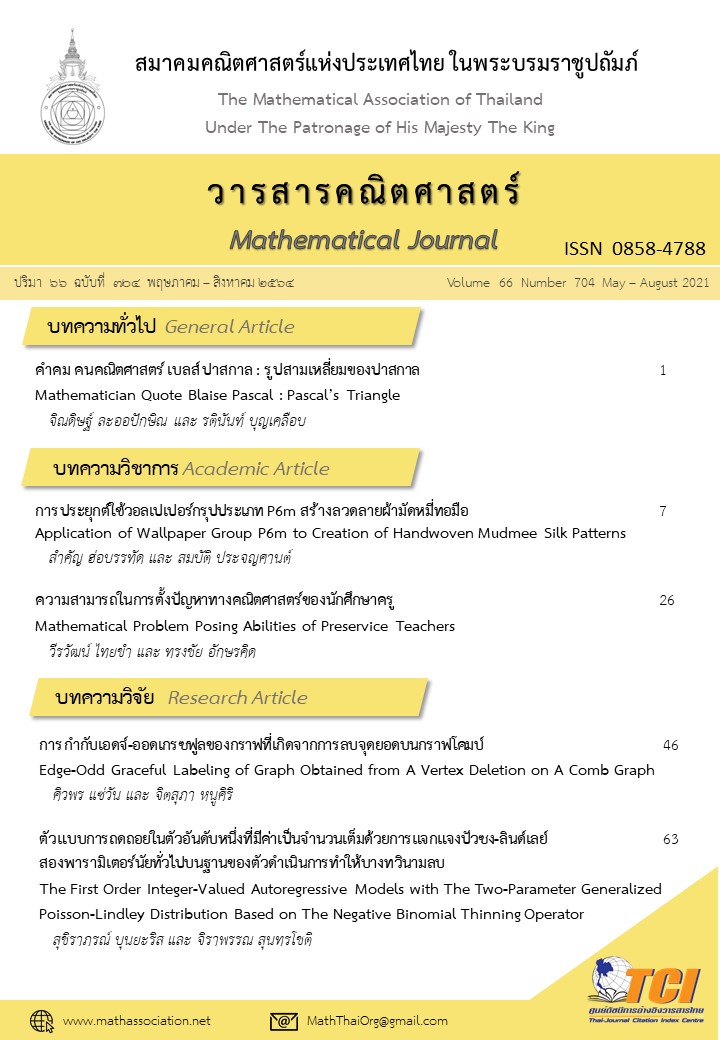การประยุกต์ใช้วอลเปเปอร์กรุปประเภท P6m สร้างลวดลายผ้ามัดหมี่ทอมือ
Main Article Content
บทคัดย่อ
บทความนี้เสนอการสร้างลวดลายผ้ามัดหมี่ทอมือให้มีความสมมาตรประเภท P6m โดยพัฒนาบนวอลเปเปอร์กรุป แม่ลายที่ใช้พัฒนามาจากส่วนหนึ่งของลายดั้งเดิมที่ใช้ทอผ้ามัดหมี่ในพื้นที่จังหวัดบุรีรัมย์ ประเทศไทย ซึ่งใช้วิธีการเลือกลายแบบเจาะจงทั้งหมด 2 ลาย ได้แก่ ลายโคมประทีป และลายขอบินไทย ผลการศึกษาพบว่า ทั้งสองแม่ลายสามารถพัฒนาสู่ลายมัดหมี่ที่มีความสมมาตรประเภท P6m ได้โดยใช้เทคนิคการค้นหมี่แบบหมี่ลวดร่วมกับการใช้เทคนิคการมัดหมี่แบบสะท้อนลาย
Article Details
เอกสารอ้างอิง
Bodner B. L. (2013). The Planar Crystallographic Groups Represented at The Alhambra. Proceeding of Bridges 2013: Mathematics, Music, Art, Architecture, Culture (p. 255 - 232). Enschede, Netherlands.
Cohen M. M. and Pilgrim K. M. (2004). Groups and Geometry: A Bridge to The Math Major. Retrieved from https://pi.math.cornell.edu/~marshall/book04-1.pdf
Fedorov E. S. (1891). The Symmetry of Real Systems of Configurations. Zap. Min. Obshch., 28, p. 1 - 146.
Glenn R. L., Haftamu M. G. Y. and Fahad M. H. K. (2014). Symmetry Groups of Islamic Patterns at The Sultan Qaboos Grand Mosque. Proceeding of Bridges 2014: Mathematics, Music, Art, Architecture, Culture (p. 183 - 190). Seoul, Korea.
Hobanthad S., Prajonsant S. and Vongpramate D. (2017) Matrix Transformation Analysis of Mee Laud Technique in Mudmee Pattern. Proceedings of 55th KU Annual Conference, Science Technology and Environment (p. 1 - 10). Bangkok, Thailand.
Lekka L. and Dascalopoulos S. (2008). Motifs and Symmetry Characteristics of The Ornamentation on Traditional Greek Woven Textiles from The Area of The Aegean. Fibres and Textiles in Eastern Europe. 68, p. 74 - 68.
Malouise A. N. L. P. and Analyn V. S. A. (2016). Mathematical and Anthropological Analysis of Northern Luzon Funeral Textile. Philipp. J. Sci., 145, p. 89 - 103.
Nagpaul S. R. and Jain S. K. (2005). Topics in Applied Abstract Algebra. The Brooks/Cole Series in Advanced Mathematics. CA, USA: Thomson Learning.
Perez-Gomez R. (1987). The Four Regular Mosaic Missing in The Alhumbra. Computer and Mathematics with Application. 14, p. 133 - 137.
Polya G. (1924). Uber die Analogie der Kristallsymmetrie in der Ebene. Zeitschrift fur Kristallograpie-Crystalline Materials. 60, p. 278 - 282.
Prajonsant S. (2018). Pojakapat, Thai Traditional Floral Mobiles : From Fine Arts to Mudmee Motifs. Proceedings of Thailand Design & Research Conference (p. 266 - 232). Khon Kaen, Thailand.
Reinhardt P. A. and Welter L. (1999). Symmetry Analysis of Embroideries on Greek Women's Chemises. Clothing and Textiles Research Journal. 17, p. 176 - 190.
Schattschneider D. (1978). The Plane Symmetry Groups: Their Recognition and Notation. The American Mathematical Monthly. 85, p. 439 - 450.
Vongpramate D., Hobanthad S. and Prajonsant S. (2018). Development of Simulation Software for Mudmee Silk from Buriam Local Wisdom. Thai Science Technology Journal. 26, p. 1264 - 1272.


